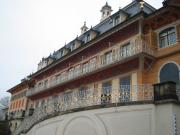 |
 |
 |
 |
 |
 |
 |
 |
A close-up of the Wasserpalais.
 |
 |
The Saxon princes' summer residence has two main wings, the riverside Wasserpalais and the inland Bergpalais, separated by a formal French garden.
The Palace
Ownership of the palace often changed. In 1694, it belonged to Prince Johann George IV. Then it came into the possession of King August the strong who at a large expenditure transformed it into a spectacular garden and castle. Often it is used for water sports in summer as it is by the banks of the Elbe River.
The transformation task was handed to one of the national building masters Matthaeus Daniel Poeppelmann. Between the years 1720 to 1723, an outside staircase was built at the water palace into the Elbe, opposite the Elbinsel. Then in 1724, the Bergpalais (mountain palace) was built. More playful than the Zwinger, the palace has a faintly Chinese air with its pagoda-like roofs. The exotic architectural style also blends some Indian architectural features and is sometimes called the "Indianisches Palais".
The Bergpalais houses a nice little arts and crafts museum (Museum für Kunsthandwerk) displaying the region's furniture, musical instruments, porcelain, crystal and pewter.
The Park
Take a stroll in the English-style landscaped park that stretches north and west of the palace. The garden surrounding the Castle was built in 1780. A breathtaking sight in summer as seen from many photographs in tourist brochures and books about the castle. The beauty of the park, somewhat reminiscent of an English garden, is kept even until today. It would seem that no time as passed at all, with the colors of the castle glowing in orange as if new and with such a well groomed garden. It's almost like taking a step back into the renaissance days.
|
